Are you looking for a good blind for taking your wife and kid hunting? This guide is for you.
We’ll answer: “what is the best ground blind for bowhunting?”
And explain: why these blinds stand out from the rest.
Ready? Let's get into it!
- Best Overall: Primos Double Bull SurroundView Double Wide
- Most Durable: Xeneks Ascent
- Biggest Hunting Blind: Barronett Ox 5
- Best Bang For Your Buck: Rhino Blinds 180 Realtree Edge
- Best Budget-Friendly Choice: Ameristep Caretaker
Best Ground Blind for Bowhunting Reviews:
1. Primos Hunting Blind Double Bull 300º SurroundView Double Wide:

Via Amazon.com
The Double Bull 300º is the best ground blind for bowhunting. It will not disappoint!
The Double Bull has been a well-known hunting blind since 1992. The Primos team have attached many neat features, keeping bowhunters in mind.
Specs:
- Height: 70”
- Hub to hub width: 60” x 60”
- Weight: 26 lbs
Key Features:
1. A massive (and invisible) field of view:
The Double Bull introduces a game-changing technology: INVISIBLE SurroundView.

Via Amazon.com
How does it work?
It works like the one-way mirrors you see in detective movies; where lighting plays a role in what can be observed from each side.
The police officer stands in a dimly lit space, observing the suspect seated in a more brightly-lit space.
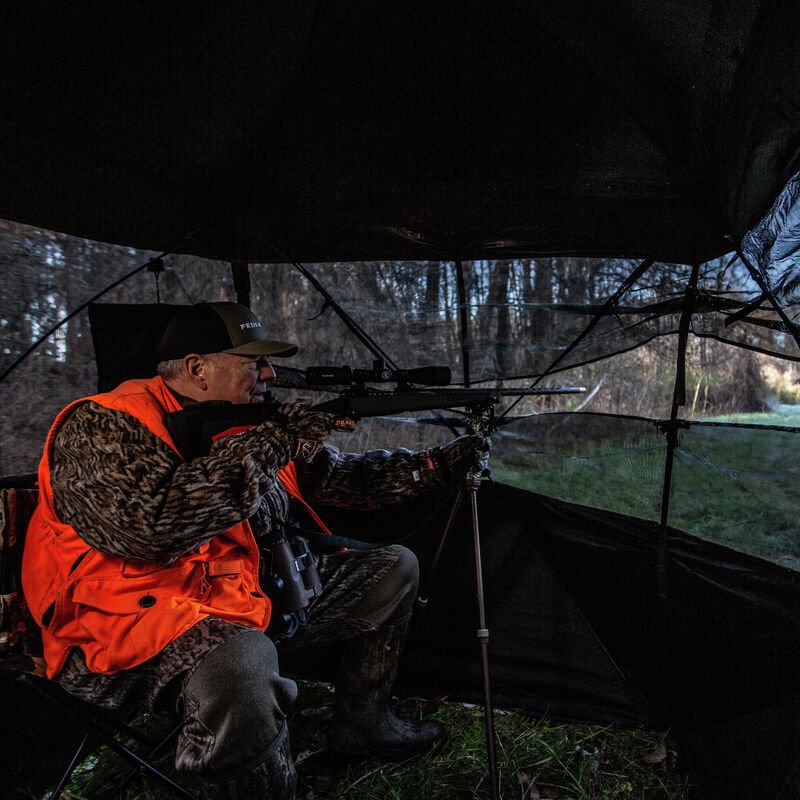
Via primos.com
Using these see-through walls, you’ll have a clear and super wide field of view (up to 300 degrees) from the inside, whilst remaining invisible from the outside.
The space and view leaves you free to move around inside the blind and change shooting angles, without worrying whether that big wise buck can detect your motion from outside.
The best part?
Once you’ve set up right, it's possible for the deer to get right up close to you, at 10 yards for instance.
It makes it easy to get a surprise shot in, increasing your chances of successfully taking down the deer. Cool, right?
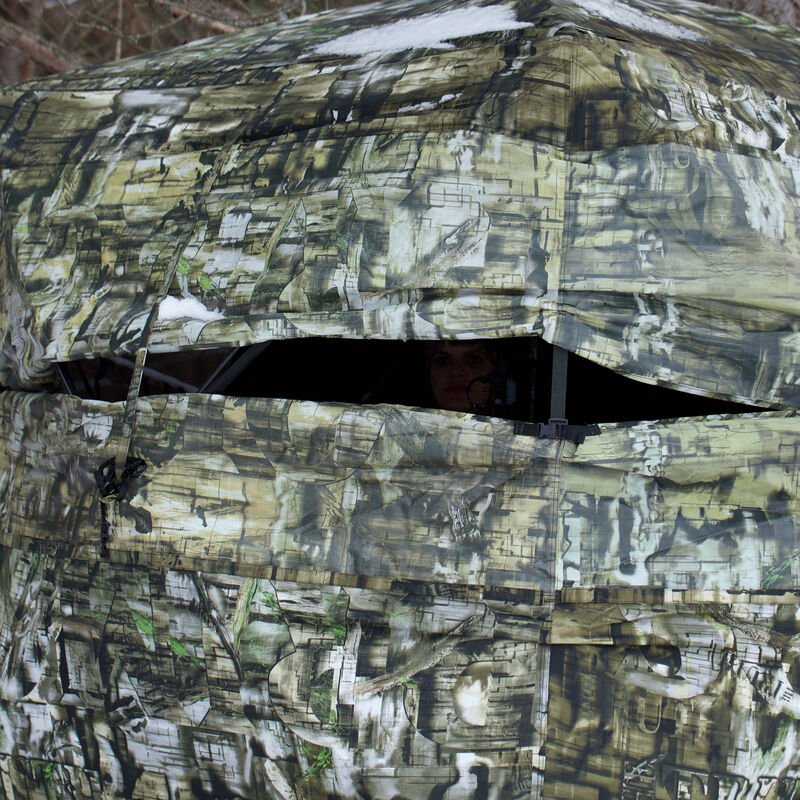
Via primos.com
Can I shoot through the windows?
Nope. The mesh material is not designed for arrows to pass through.
If you plan to bow hunt from the blind, you MUST open the see-through windows before shooting out of it. OR your shot will be off.
What if the deer suddenly appear at my back?
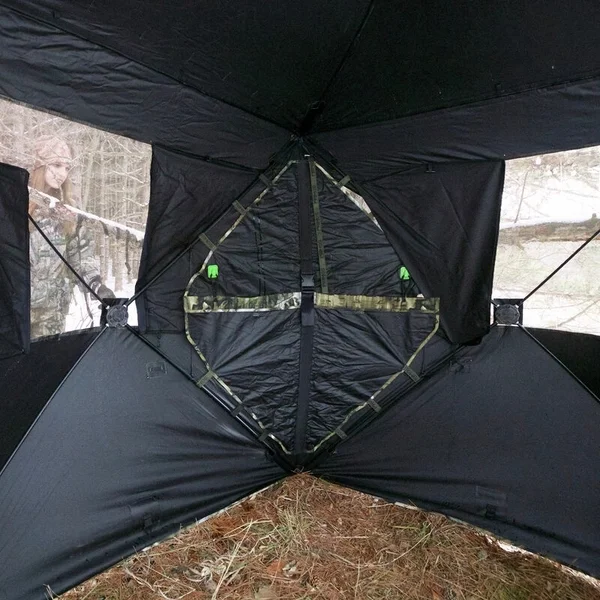
The 4 see-through walls allow you to see your prey from the back and the sides, greatly improving your awareness of the surroundings.
So, there’s no reason to get surprised anymore by a doe appearing out of nowhere.
Additional concealment
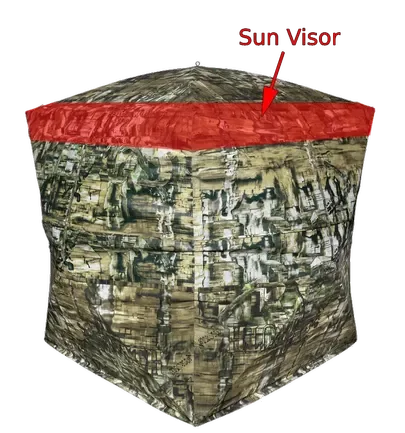
Via primos.com
The built-in sun visor adds another layer of concealment.
Typically using a standard blind, the sun can shine directly on you at different times of the day.
In those times it lights you up, creates a silhouette, and is more likely to spook the deer.
The sun visor eliminates these issues, preventing the sun from highlighting you. Cool, right?
2. Spacious for 2 people:
The interior has plenty of room for 2 bow hunters.
The space gives you the ability to get into a better shooting stance, resulting in more accurate shooting.
It makes it more comfortable to draw a vertical bow without reaching your elbow.
Jumbo door
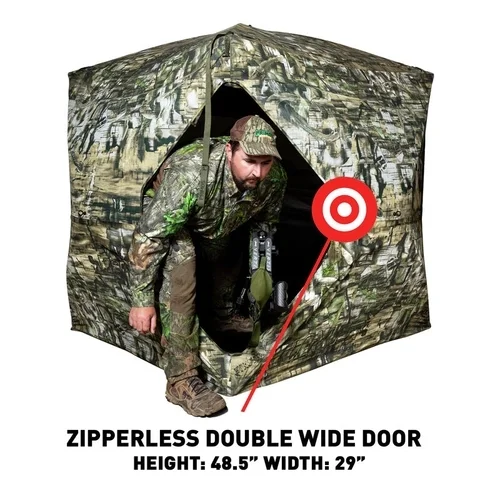
The huge door is sufficient for most big guys and those who drag in a ton of food and gear.
You can get in and out silently. As it features NO ZIPPER, only uses quiet buckles instead.
The door’s also beneficial for older hunters who find it difficult to squeeze in through small awkward spaces. This setup really is suited to everyone!
3. Portable Large Bag:

Via Amazon.com
The Primos team upgraded the bag to come with a strap. It frees up your hands to also carry the bow while hauling your blind out there.
The old bags needed the blind to be squeezed up and lid into a tight bag for storage, but now they've made it much easier. By widening it and adding a zipper, it is now much more user-friendly.
Easy. Efficient. Hands-free carrying.
Wait… there's more:
The small side pocket fits a trigger stick tripod or a stool chair pretty well.
And they bundle all of these advanced features together with LEGENDARY quality, including:
- CVC fabric that is water resistant and built to last
- Primos exclusive TRUTH Camo that blends you into the surrounding brush
- Hub system design that is easy to put up and take down
- High roof for standing up
- Lifetime guarantee
Who doesn’t love a lifetime guarantee?
Did you know?
“Tree stand falls are the number 1 cause of hunting fatalities” (Citizen-Times).
It means hunting from a ground blind is much safer for you and your family.
Drawbacks:
Rain, wind, and scent get through
The thousands of holes on mesh windows allow the winter wind, rain, and scent to get in and out fairly easily.
Imagine how freezing it is when you’re hunting out of it while the outside wind blows at 15 - 20 mph when it’s 13 degrees out.
You’d better be prepared with thick hunting clothes, blind heaters, and scent control products. They’ll help to guarantee your comfort, warmth, and keep your scent under control.
Heavy
This hub-style ground blind is pretty heavy, weighing in at 26 lbs.
If you’re not hitting the gym regularly, you’ll feel the pain of hauling a few hundred yards into the bush.
My suggestion: either try to find a set up spot that’s not too far away from your truck, or (if safe enough) leave it out there for the season.
Pricey
Obviously, the price tag is a little on the higher side.
Considering its tough quality, invisible SurroundView, and roomy space, it’s worth the money.
Pros:
- Massive field of view
- Keeps you well hidden inside (out of sight of deer)
- Heavy duty material
- Zipless entrance
- Quiet operation
- Large entry window to help bigger or older guys
- Easy to put up and take down
- Huge space (fits 2 large adults)
- Pretty high for standing up straight
- Powerful frame
- Backpack style carry bag
- Lifetime warranty
Cons:
- Low protection from rain, wind, and scent control
- Pretty heavy
- Pricey
What if I’m looking for a MOST DURABLE ground blind to replace my old one?
Check out the Xenek Ascent below!
2. Xenek Ascent Ground Blind:

Via Amazon.com
The Xenek Ascent is the most versatile and durable blind on our list.
It is as tough as the Primos, but bigger, cheaper, and has a bunch more features.
Specs:
- Height: 73”
- Hub to hub width: 72” x 72”
- Weight: 25 lbs
Key Features:
1. Most shooting opportunities.
The Ascent maximizes your shooting opportunities by optimizing the window configuration.
Large front windows
You can slide the mesh windows up to get a wide panoramic view or narrow it down to minimize exposure.
The mesh allows you to shoot through with minimal impact on the arrow flight.
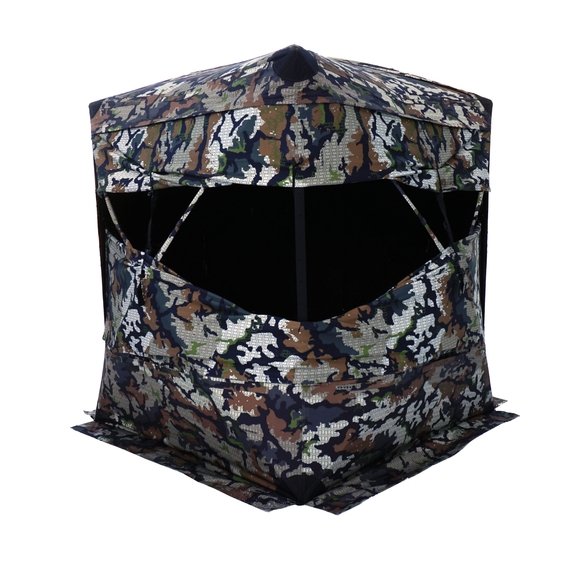
Via huntxenek.com
Not only that
The black coating keeps your inside looking really DARK.
It levels up your concealment and improves your odds of a successful hunt.
Quiet rear windows:
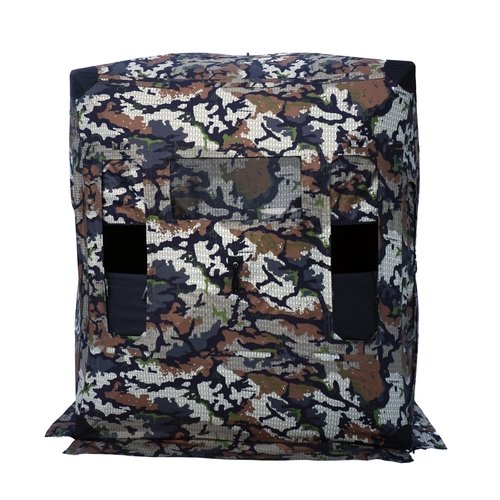
Via huntxenek.com
Many small rear windows can be adjusted by zippers or by sliding up or down to create additional shooting opportunities.
So you won’t miss the shot in case a turkey appears at your back.
All of the height adjustments operate with minimal noise.
The best part: One-way vision window
There’s a rear window that features a one way (see-through) window.
It works like the SurroundView of the Double Bull above but in a more restrictive way.
You’re able to see or aim a crossbow through the window while a boar walks slowly to your spot, keeping you invisible from the outside.
Besides that, you can put them up or down to adjust the brightness.
Why don't they apply 1-way vision for all the windows, like the Double Bull?
Well, one way vision windows leak water, scent, and wind. So the more windows you have, the more likely you are to be exposed.
2. Most durable deer blind:

Via huntxenek.com
The Ascent is the MOST DURABLE BLIND on our list.
Surely you can leave it set up in the woods from September through to January, whilst keeping peace of mind that it’s staying in-tact.
It features a built-to-last design that can survive throughout the seasons, including:
- Thick 600 Denier polyester fabric is the toughest material on the market. It’s also water resistant, keeping your gear dry under light rain.
- Multi-layer black polythene coating inside.
- Reinforcement on all of the corners and hubs for extra durable construction
- Additional internal gusset to key windows corners to prevent tearing
- Double inner webbing inside the rod sleeve to ensure they don’t poke through
- Upgrading to solid fiberglass rods instead of hollow rods, and a steel hub frame instead of cast aluminum.
- Lifetime warranty for rod, hub, and mini-mounts.
3. A bunch of additional features:
You can’t find all these neat features on any other blind on the market.
The Ascent is made with hunting filming in mind.
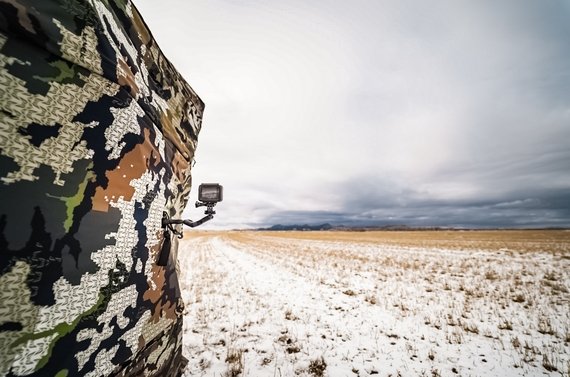
Via huntxenek.com
Here’s how it eases your camera setup:
- Every corner has built-in mini mounts for an action camera or smartphone. Who doesn’t love having your shots filmed from multiple angles?
- The tripod slots at the bottom allow you to extend one leg of the tripod to the outside.
- It prevents your video camera from “eating up” the inside space while adding a better field of view for your camera.
- The backpack has lots of additional pockets without spending extra money for a hunting pack.
- You get a ton of space to store your hunting gear, such as cameras, turkey/deer calls, a tripod, memory cards, and snacks…
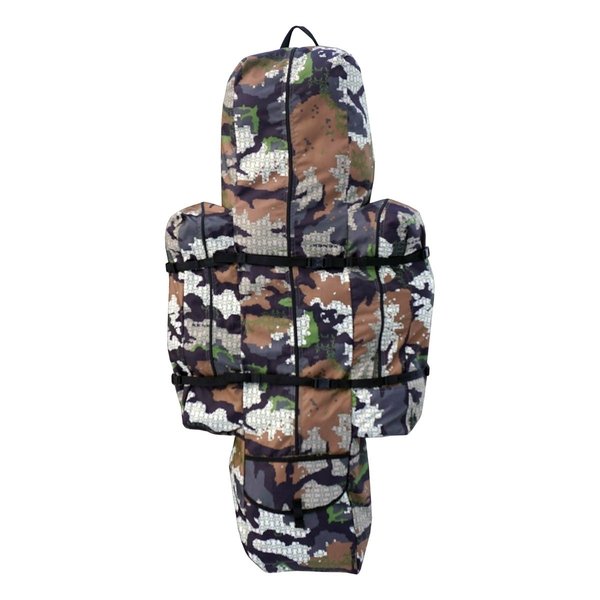
Via Scheels.com
Think of how EXCITING it would be for your kid when he kills his first called-in gobbler out of this blind.
Trust me; you don’t want to miss this moment. You can record it and share the excitement with friends and family now.
Here’s one of my favorite parts: VERSATILE TREKKING POLE (sold separately)
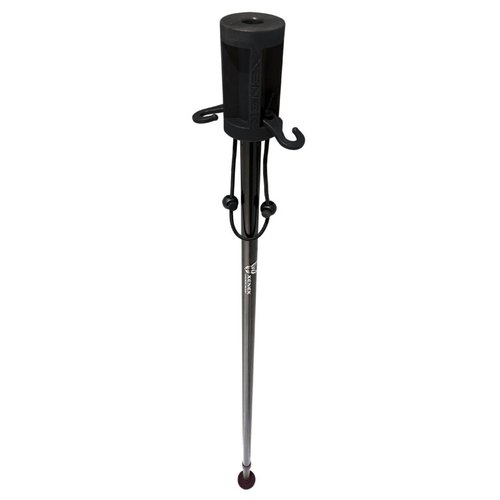
Via huntxenek.com
You can easily mount the trekking pole to the hub which helps the blind to withstand an ice storm or heavy snow.
Or use it as a genuine trekking pole or shooting stick for crossbow hunting. Pretty sweet, right?
Drawbacks:
On the heavy side
As with the Primos Double Bull, the Ascent weighs up to around 25 lbs. You’d better haul it to a hunting spot that isn’t too far into the woods.
Not cheap
Although it’s cheaper than the Primos, this deer blind is still costly.
Considering the durability and weatherproofing, the Xenek Ascent is hard to beat.
Obviously, it’s much better than getting frustrated by a cheapo blind that barely makes it through a season.
Harder to set up than the Primos
Since the Ascent is taller and broader than the Primos the setup process is less straightforward.
That said, it's still reasonably easy, quiet, and fast to install.
Pros:
- Built like a tank
- Thick strong material
- Panoramic windows
- Quiet design
- Roomy and comfortable for 2 big hunters
- One way vision window
- Black coating inside
- Ideal for self filming
- Big silent entry and exit door
- Lots of brush loop
- Versatile trekking pole
- Easy to set up and takedown
- Great customer service
- New Xenek’s DSX camo
Cons:
- Pretty pricey
- On the heavy side
- Harder to set up
- No see-through windows
Wait… what if I go hunting with my wife and 2 kids… 4 people in total… Which blind would be a good fit for me?
The Barronett Ox 5 is our recommendation.
3. Barronett Ox 5 Portable Hunting Blind:

Via Amazon.com
The OX 5 is the best bang for your buck ground blind.
It’s as solid as the Primos Double Bull, but much larger, lower cost, and more straightforward.
Barronett first introduced it in 2017, and the design continues to hold up to date.
Specs:
- Height: 72”
- Hub to hub width: 96” x 96”
- Weight: 33 lbs
Key Features:
1. Go big. Go OX 5:
Unlike other standard blinds, the OX 5 features comfortable and ENORMOUS SPACE (up to 96" x 96").
The 5 side blind provides 70% more interior room than a conventional 4 side one.
In particular, it fits a small family of 4 people, hunting and camera gear.
The extra space also allows for stabilizing a crossbow on a shooting stick.
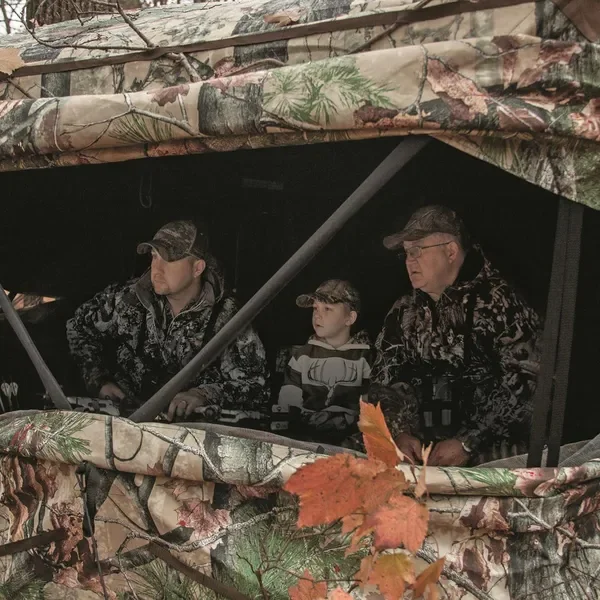
Via sportsmansguide.com
Let’s face it:
Your kids just don't sit still, no matter what. An oversized blind leaves adequate space for them to play around.
Plus, its tall height is ample enough for a medium-sized hunter to stand up and draw a bow, with room to spare overhead.
2. Super durable:
Instead of thin material that fades after a season, the OX 5 has bonded 2 thick layers into the OxHide fabric.

Via barronettblinds.com
So, its durability is pretty close to the Ascent and guarantees that your blind will be:
- Soft
- Without fade
- Well camouflaged
- Waterproof
- Toasty warm
- And super heavy duty
There's more:
All of the corners are reinforced for extra durability.
The fiberglass poles and aluminum hub create a solid and long-lasting construction.

Via Amazon.com
Let's think about it:
It’s built-to-last throughout multiple deer and turkey seasons. It means you can ensure a comfortable and effective hunting spot, every time you head out.
Is it waterproof?
Instead of being water resistant like many other blinds on the market, the Ox 5 is 100% WATERPROOF.
It ensures you keep yourself, your family and your gear bone dry regardless of how the conditions change throughout the hunt.
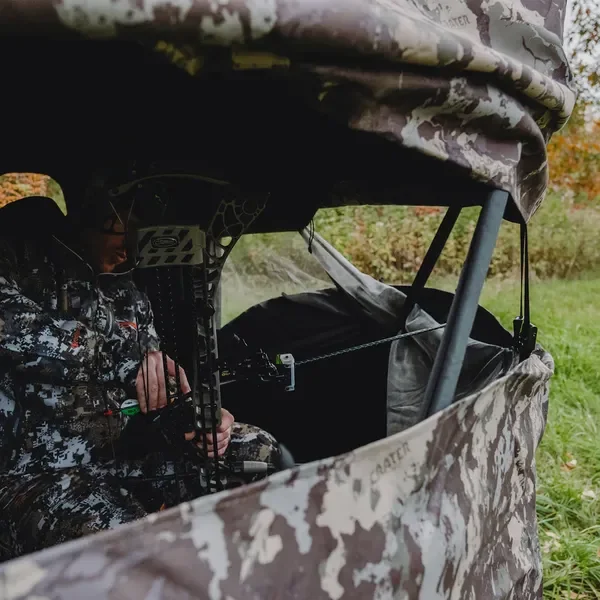
Via barronettblinds.com
Want to know my favorite part?
The thick outer shell, AND sealed-up windows, traps the heat inside and keeps your crew WARM throughout the colder days.
3. Panoramic 270 degree windows:
You’ll be impressed by the panoramic windows on the front side. It gives you great visibility (up to 270 degrees) and better concealment.
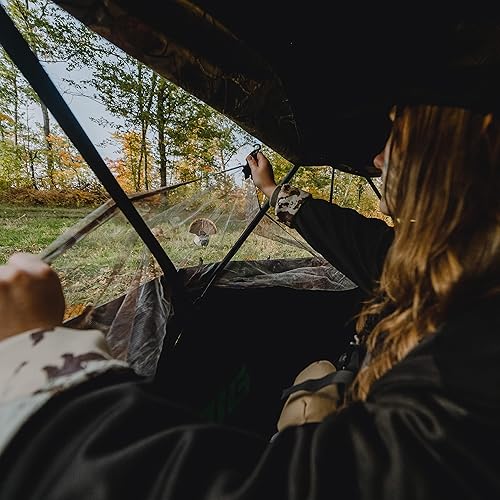
Via Amazon.com
Adjusting the shooting-through mesh is relatively easy, smooth, and quiet.
Your kids can slide them down low enough to shoot through without making noise.
The black-out walls also hide you and your kids out of view from the outside world.
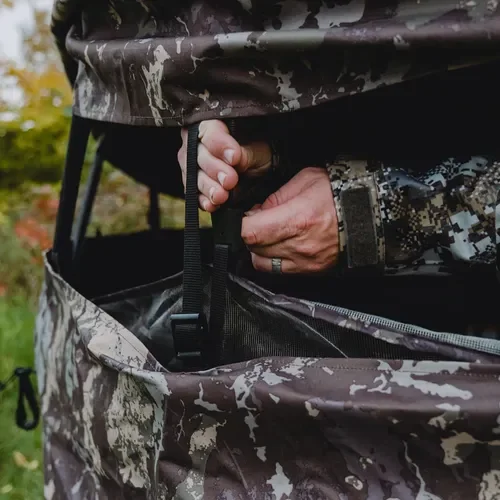
Via barronettblinds.com
Is it going to break the bank?
Nope, the OX 5 covers all of these cool features that you only really see on the super premium blinds, but at only 70% of the price of the Primos blind.
Awesome, right? No second-guessing needed here!
Drawbacks:
Small entry door
The D-shaped door is pretty small, so the big guys might have some trouble getting in and out.
The zipper can be a little loud when you open and close it.
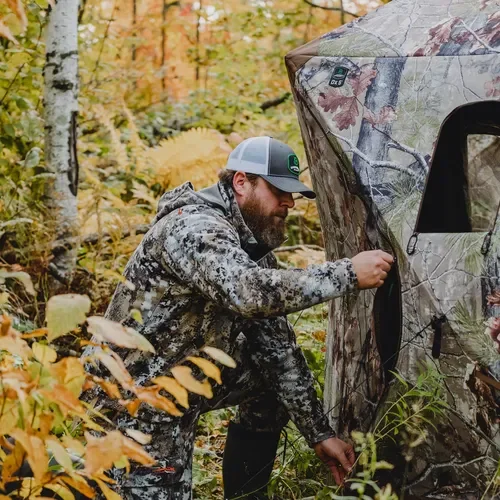
Via barronettblinds.com
Short warranty
What a shame, the Barronett only offers a 1-year warranty.
Undoubtedly they stand behind their products, but I prefer the lifetime warranty by Primos.
Heaviest blind
It’s the HEAVIEST blind on our list, weighing in at 33 lbs.
It’s probably best to find a safe place to hide it and lock it up out in the woods rather than carting it in and out every time.
But wait…
When you compare its weight, quality, and giant interior space, this blind is the best value blind for the money.
Pros:
- Enormous interior room for 4 people
- Super durable fabric
- 100% Waterproof
- Broad panoramic viewing
- Heavy-duty backpack bag
- Lots of pockets and spots for attaching brush, cedar brands, grass…
- Sturdy ground stakes and ropes to stabilize the blind to the ground
- Easy to put up and take down
- Best bang for your buck
Cons:
- Heavy
- Small entry door
- Short warranty
- No see-through windows
Did you know?
Mark Kenyon (founder of Wired To Hunt) has been hunting from a ground blind for more than 2 decades. It helped him to harvest the biggest buck of his life.
If he can do it, you can too.
People often say, "You can’t get a good ground blind under $200”.
Wait until you check the Rhino Blinds 180 below. It’ll open your eyes.
4. Rhino Blinds 180 Realtree Edge:

Via Amazon.com
The Rhino 180 is the best ground blind for turkey hunting.
It offers a similar window configuration to the Primos Double Bull, however it is larger and lighter, but less durable.
Specs:
- Height: 66”
- Hub to hub width: 75” x 75”
- Weight: 16 lbs
Key Features:
1. See through windows:
Like the Primos Double Bull, the Rhino 180 features advanced see through windows.
Unlike the Primos, which includes 6 small black blind spots and a ground skirt, the Rhino has full “cinematic-hall” walls.
Sitting in front of the giant walls feels like watching National Geographic on a wide spanning cinematic screen.

Via Amazon.com
And again:
The Rhino gives you a massive and crystal clear viewing area (up to 180 degrees). You can look around from the inside without being seen from the outside.
There’s a chance that a few turkeys pass by without even knowing you’re in there.
Is it easy to use?
Adjusting the “silent sliding” windows is smooth, comfortable, and easy.
Let's say a turkey is 20 yards away from your spot; you could move around without it seeing you.
You can always slide the windows down quietly before surprising him with a nice ethical shot.
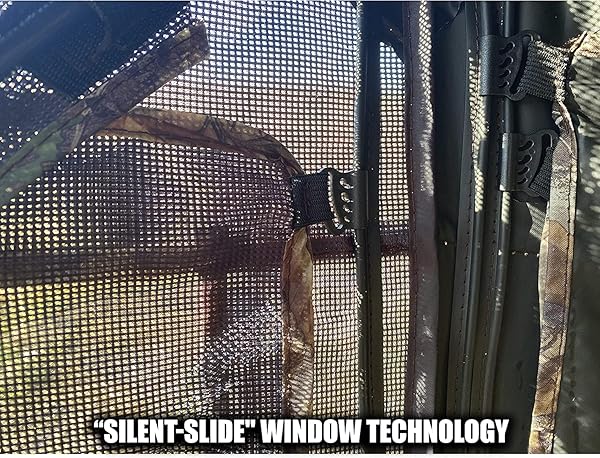
Via Amazon.com
Caution:
Since the mesh is not designed for shooting through, you must open the windows before shooting if you want the blind to last a while.
2. Ample room for 2 people:
It’s comfortable for 2 adults, OR 1 adult and 2 kids.
If you’re a big bowhunter, it’s spacious enough to be at full draw without much restriction.
Deadly quiet
This is a NO ZIPPER blind. All the buckles and clips work flawlessly without making noise.
It means there’s much less risk of spooking your prey.

Via Amazon.com
3. Lightweight:
The Rhino is a truly portable pop up blind. It’s easy to pack in and out of the woods, each time, with no hassle.
Here’s the truth:
It’s 50% lighter than the OX 5 (at 16 lbs only) and 50% cheaper than the Double Bull.
Obviously your pocket will thank you for that.
Drawbacks:
Breezy in cold weather
Bear in mind that the mesh windows let water, cold wind, and scent get in and out easily.
That’s why I recommend using it for turkey season only.
I recommend that you DO NOT hunt deer out of it since their nose is much more sensitive than turkey’s, as it doesn’t conceal scent very well.
Attracting deer is much more challenging if the wind isn’t working in your favor.
Pro tips:
Regarding scent control, when I put the ground blind up, I spray it well with a scent killer.
Don’t take the ground blind on the day you want to hunt without letting it air out a bit. The fabric can smell like plastic and the coating on the fabric.
Pretty short hub
The hub is pretty short, only 66”. Taller hunters may feel uncomfortable standing and drawing.
Thin material
The fabric is pretty thin and can LAST 1-2 SEASONS. If you plan on trying to use it longer, it would be better to grab one of the more durable blinds listed above.
Besides that, do not set it up on windy and rainy days, or it could fall apart.
Leaks water
The entry door is easy to get in and out of, but it also leaks water when it’s raining.
Pros:
- Giant see-through walls
- Ample for 2 adults
- Super quiet
- Lightweight
- Reasonable price
- Good customer service
Cons:
- Not so durable
- Shorter in height
- Breezy on cold days
- Thin material
- Flimsy entry door
And now, I want to show a budget-friendly ground blind. Here it is:
5. Ameristep Caretaker:
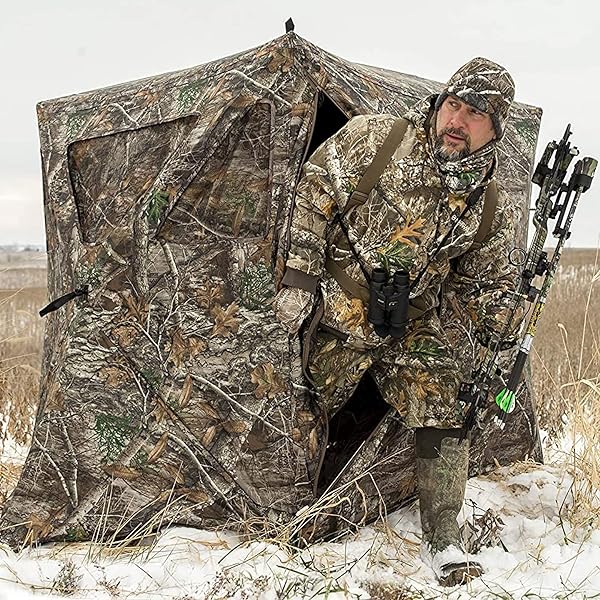
Via Amazon.com
The Ameristep Caretaker is the cheapest, lightest and easiest to set up blind on our list.
It’s a great deal for hunters who want to have some good memories with kids in the field but don’t want to break the bank. More suited for the casual fair-weather hunter.
Specs:
- Height: 66”
- Hub to hub width: 55” x 55”
- Weight: 13.5 lbs
Key Features:
1. Shoot through mesh:
The Caretaker is nice for both deer and turkey hunting.
The shoot-through mesh provides a reasonably clear view. You can shoot through the mesh windows without opening them beforehand.
The black ShadowGuard behind covers your appearance by preventing silhouettes.
Wearing all black clothes will help with extra concealment while you sit inside.
Did you know?
Ameristep is a well-known hunting brand with 20+ years of experience. They produce affordable ground blinds and gear that make hunters “invisible” in the woods.
But… there’s a problem:
Unlike typical blinds, the Caretaker has no windows along the side and back walls.
It means you can’t spot prey that comes up from behind you.
It’s not a big deal if you’re not a 360-degree hunter or set up in an area that naturally has a smaller opening.
2. Side storage:

Via Amazon.com
You'll be impressed by 2 unique “kick outs” at the side corners.
They provide extra space for your backpack, heater, and hunting chairs... And as it’s off to the side, you don’t have to worry about bumping them and making noise.
Double zipper door
There are 2 zippers for the door. You can unzip both to extend the width of your blind a little bit.
However, the door is pretty narrow and loud to get in and out of.
3. Saves you money:
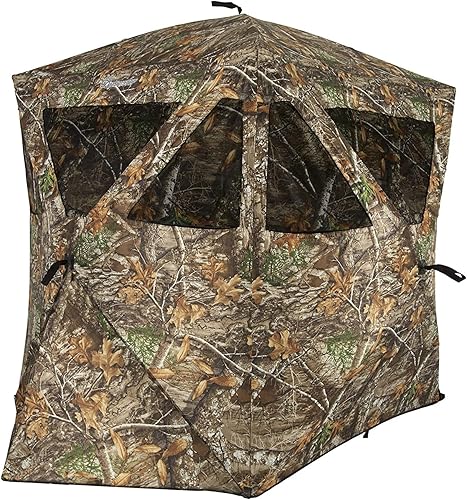
Via Amazon.com
This pop up blind’s features are nothing groundbreaking, but hey it is functional and budget friendly.
Actually, this is the cheapest hunting blind on our list.
It’s a good fit if you wanna save some money for your other hunting gear.
But don’t expect it to be a blind that will last for years. Ultimately, you get what you pay for.
Drawbacks:
Small dimensions
The Caretaker is a bit tight for 2 adults. I recommend it for one larger man with gear OR one man with a child.
Weak construction
You should strengthen it by adding stakes and center poles to withstand strong winds and heavy snow, or it is at risk of getting damaged.
No sun visors
When the sun shines directly on the blind, you may cop some real glare, making it difficult to see very well.
Pros:
- Shoot-through windows
- Additional side storage
- Double zipper door
- Budget friendly
- Water-resistant
- Easy to set up (taking just a couple of minutes)
Cons:
- Small dimensions
- Weak build
- Lots of sun glare
Wrapping Up:
So… Our choice for the best ground blind for bowhunting is the: "Primos Double Bull 300º SurroundView Double Wide".

Via Amazon.com
Here’s why it’s the most trustworthy choice:
- Exclusive One-Way See-Through Design
- Spacious for 2 or 3 people
- Huge door
- Large bag for portability
- Built-to-last quality
- Blended TRUTH camo
- High roof
- Quiet operation
- Easy to put up and take down
- Lifetime guarantee
What’s your favorite deer hunting blind? Let us know below.
These also are great options if you hunt with a companion:
